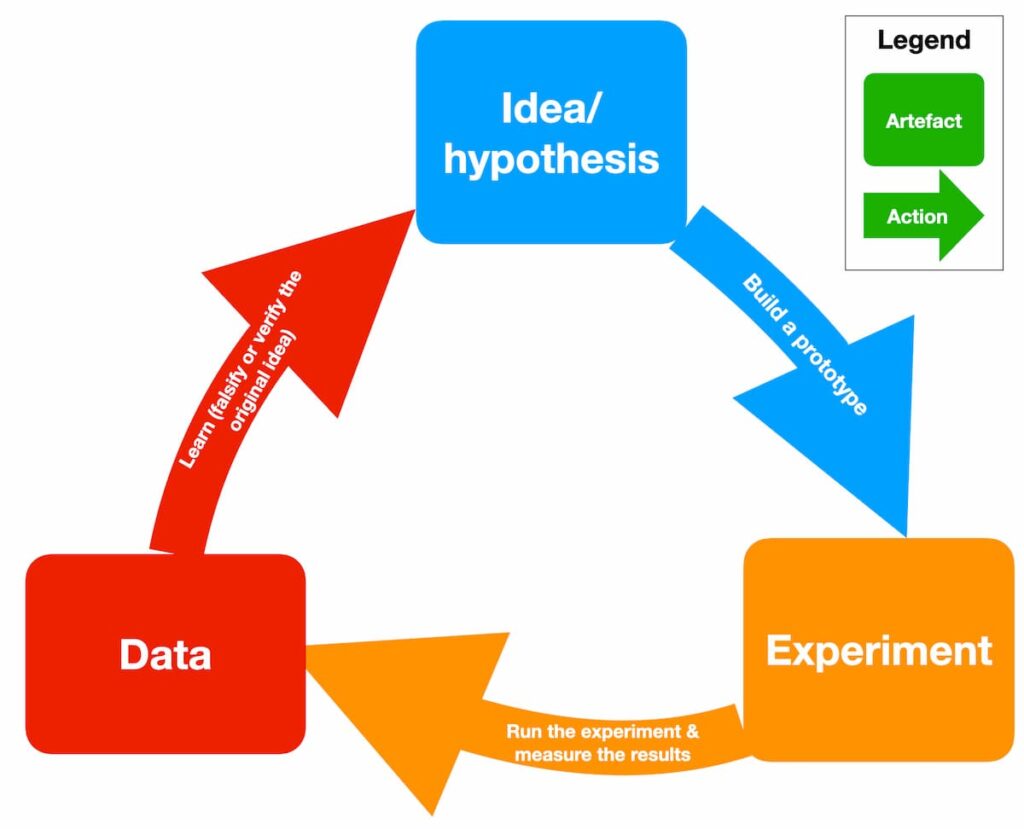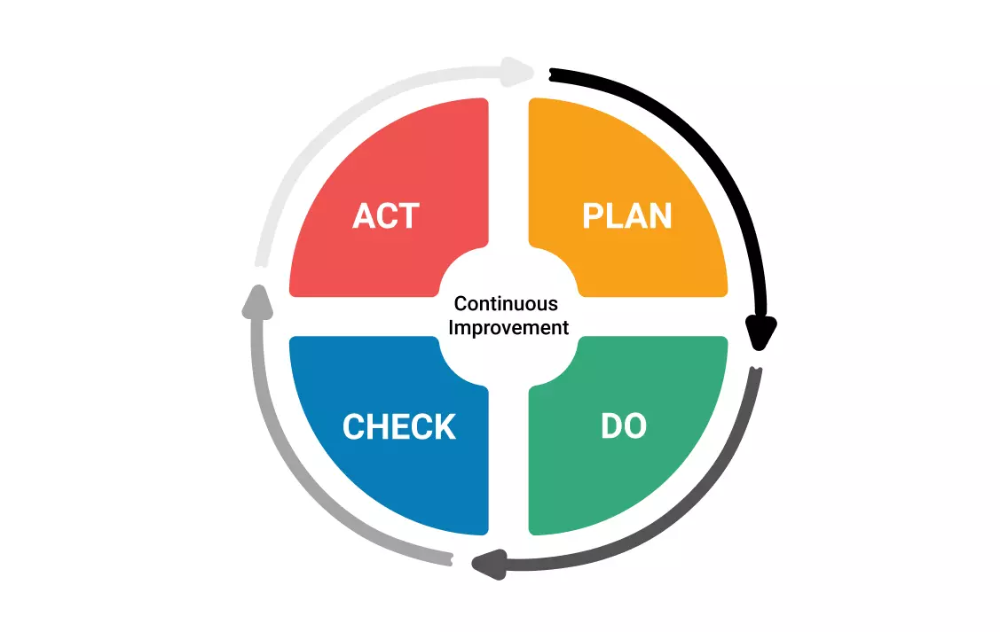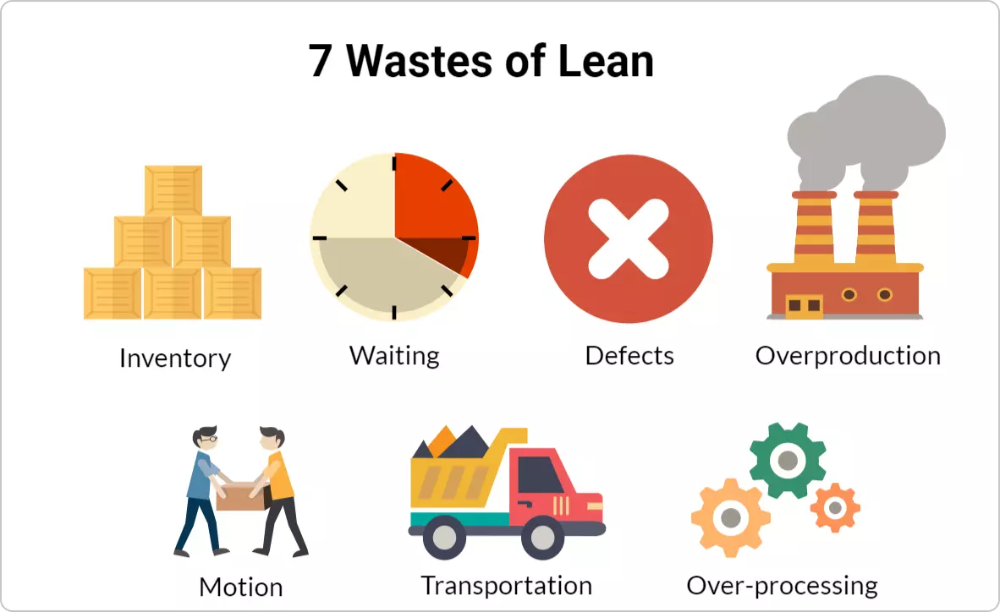I like Lean projects because they’re quicker. Moreover, they encourage us, team members, to constantly improve our workflow and skills. If you also want to implement a project management framework focusing on continuous improvement, you should consider Lean.
With this solution, cross-functional teams are easier to put together. Also, it will be easier for all your employees to work together towards achieving a common goal.
Below, I’ve detailed some of the most important aspects of Lean methodology that you should know about: what it is, its main principles and stages, pros, cons, and a few alternatives.
Key Takeaways
- The lean framework involves constant improvement, a specific type of thinking, and added value with limited waste;
- It has five principles and four stages, among which there are planning, testing, seeking perfection, and creating a smooth workflow;
- To work excellently, one must apply Lean principles throughout the company, not only to one single project.
Complete Guide to Lean Project Management
Today, I’ve decided to let you know what Lean projects are all about, including their stages, principles, and main alternatives.
What Is Lean?
Lean is an Agile project management methodology through which companies can optimize their efforts, teams, energy, finances, and all other resources. Lean projects have the goal of delivering high-value products to clients. This framework has two focus pillars:
- Respect for all those involved, from team members to clients and stakeholders;
- Continuous improvement.
Teams must create valuable products with little to no waste and fewer resources.
Lean Stages

There are four main phases in Lean projects.
Hypothesize
This part is where specialists try to predict the future by stating what they think the outcome will be. Experts rely on past data and previous experience to draw conclusions regarding their current projects. Based on their observations so far, they can now define more precise goals, rules, outcomes, and guidelines.
So, this Lean stage is all about:
- Making predictions;
- Drawing conclusions.
Plan
With the new hypothesis in mind, teams can now create the project’s design or adjust the existing one. Team members handle different plan-related activities like building new models, drafting experiments, developing demos, debugging, etc. Prototypes and improvements are also made during the Planning phase.
So, the planning stage is all about incorporating design changes.
Test
Lean’s third step is when teams start to test their hypothesis and newly-crafted designs. They use the prototype as a way to undertake the experiment. Next, employees run trials while gathering valuable data at the same time. Finally, simulations are performed, and a lot of decision-making occurs.
Hence, testing is the stage that involves experiments and data gathering.
Interpret
During Lean projects, specialists interpret data through analysis and synthesis. These methods help them achieve a clearer and deeper understanding of the project’s principles. Once this phase is finished, teams complete one iteration and then return to phase one. Lean projects’ cycle consists of several iterations; each iteration requires you to go through these four stages.
Interpretation stages are also known as the Check or Study phases. Therefore, interpretation involves data analysis, evaluations, and result synthesis.
Lean Principles
The Lean framework has the following principles.
Defining and Delivering Value
A Lean project’s value is what clients receive and what they’re willing to pay for. This Lean principle helps teams find out what clients need and want. Despite knowing what they need, I’ve seen numerous customers who couldn’t articulate those desires. Many of those situations occurred in tech firms, being linked to new software or novel products.
My team uses quantitative and qualitative methods such as surveys, web analytics, interviews, and demographic information to reveal what our customers perceive as valuable. Ask yourself the following questions:
- How long will it take to create and deliver what my client wants?
- What’s the price clients are willing to accept?
- What other essential requirements or client expectations should my team meet?
Mapping the Value Stream
Starting from your customer’s value reference, you must identify all the activities that lead to those results. All other initiatives that don’t bring value are seen as waste. There are two types of waste:
- Unnecessary and non-value;
- Necessary but non-value.
You should eliminate the first while reducing the second as much as possible. This principle was truly eye-opening for me.
Creating Flow
Once you remove waste, you can complete the following process steps. But make sure the workflow is smooth, free of delays or interruptions. Over time, I applied several strategies that worked in creating flow:
- Workload leveling;
- Breaking down steps;
- Working with cross-functional departments;
- Production steps reconfiguration;
- Easily-adaptable and multi-skilled team members after proper training.
All the above helped me boost team productivity and reduce project completion time.
Establish Pull
Production systems consider inventories as waste. Pull-based systems work with limited inventories. That also means that the items clients need are readily available to them. Pull systems allows us to create the correct quantity of products and deliver them in due time. Simply put, you must do your best to meet your customer’s needs.
Avoiding stockpiling items will save you money, time, and effort.
Aim for Perfection
I consider this the most important Lean principle. Teams should strive to implement the above principles throughout the company. Great company cultures rely on continuous improvement and lean thinking. Lean systems aren’t static. All employees should be involved in developing a perfect organizational process through constant vigilance.

Pros and Cons
Lean has both pros and cons. You’re about to find them all below.
Lean Advantages
- Less infrastructure – you only have to use the necessary space, tools, workforce, and supplies that the project needs; less infrastructure means less waste; you won’t see teams hanging around and wasting time without something to do;
- Limited waste – Lean focuses mainly on limited waste. There’s no excess inventory which means Lean projects are also cost-effective;
- Boosted worker satisfaction – the entire production team is involved in Lean projects. Hence, their involvement and the manager’s authenticity increase employee satisfaction. To see these results, you should include your workers’ ideas in the project;
- Competitive edge – this advantage is brought by improved efficiency and reduced costs. Companies that apply the Lean approach will undoubtedly gain an essential competitive advantage and surpass their competitors;
- Fewer production errors – this benefit results from fewer unnecessary process steps. This further leads to high-quality products and satisfied customers;
- More productive and efficient teams – team members are motivated and have high morale, which translates into boosted productivity. They feel that their opinions are valued;
- Strong customer relationships – through Lean projects, you can gain loyal customers and boost client retention. It’s the opposite of mass production, where important details are overlooked. This project management framework allows teams to create customized products.
Lean Disadvantages
- Low error margin – workflow interruptions may occur because of raw goods delivery times. Lean frameworks are pretty aggressive regarding deadlines, leaving teams vulnerable regarding bottlenecks. Another issue might be a maintenance emergency which lowers productivity. All these problems can be tricky to handle or balance;
- Missed deliveries – this issue can appear because of Lean’s low error margin and low level of flexibility. If you don’t deliver the products on time, you might lose your customers. In many cases, companies don’t receive a second chance;
- Inventory issues – focusing so much on waste elimination might lead to inventory issues.
- Frustrated workers – some employees might feel discouraged by the refinement level of the Lean method. Any Lean environment faces this challenge. Primarily larger companies can deal with frustrated workers, while smaller businesses could be able to avoid it due to their higher level of process refinement;
- Upfront expenses – companies must spend some money before the project starts, especially when it comes to creating new products, software, training systems, and equipment. Still, many times, this approach is worth it in the end.
Lean Methodology – How to Implement It

To properly implement the Lean framework, you should follow these subsequent guidelines.
Finding Your Way
You must understand how to apply Lean and then explain it to your team. You’ll achieve your customer-oriented goals if your employees are well-trained and Lean-wise skilled. Understanding the why that your actions rely on is essential.
Identifying and Addressing the Company’s Needs
Oftentimes, organizational needs are pretty conflicting. That’s why it is so important to establish those needs and address them. Here are the three types of needs found in enterprises:
- Individuals‘ needs – employees must feel safe and happy to keep working for your company; they must have a sense of stability;
- Functions‘ needs – each organization should consist of several functions to operate more efficiently, or that’s how Agile companies do it properly;
- Companies‘ needs – each activity a company engages in should come with certain benefits and well-estimated costs. Lean is an Agile solution that focuses on value control.
Becoming a Champion or Searching for One
Managers or leaders should remain vocal and visible while celebrating accomplishments and facilitating difficult discussions. All these are a must if you want to reduce waste significantly. As a leader, you must inspire and motivate your team to continue even when things get complicated. Teaching employees to overcome challenges should become part of your organizational culture.
How should you do all this? Well, it’s quite simple, to be honest. You can use informative meetings, data presentations, engaging articles, retrospectives, and standups.
Mastering the Basics
Lean principles are quite simple. However, many working environments are complex and constantly changing. Hence, this framework can become a bit tricky to implement. To make things easier, you should think, act, and respond in a way aligned with the Lean methodology. In other words, it helps if you can re-train your way of thinking.
Developing a Culture of Experimentation
Instead of trying to eliminate failure, handle its impact on the project as a whole. Traditionally, failures are bad. That couldn’t be more wrong. I learned, through Lean, to see these negative moments as teachable lessons. Each day, with any project, we’re taking risks. In my book, failures represent those risks that couldn’t be avoided.
You can embrace failure by testing your ideas multiple times, asking clients and stakeholders for honest feedback, asking employees for new ideas, and not being afraid to fail at first.
Possible Lean Wastes

There are seven Lean wastes, and I’m about to detail each one.
Inventory Waste
- Unprocessed inventory;
- Storage and capital waste;
- Containers and transportation waste;
- Obsolete inventory.
Defects
- Standards deviation;
- Improper product design;
- Defective or bugged products.
Excessive Production
- Stocking unused products;
- Wasted storage space;
- Wasted materials;
- Spoiled products;
- Obsolete goods.
Over-processing
- Unnecessary components;
- Additional features that are never used;
- Offering more value than what the client needs and requires;
- Raw material excess;
- Labor excess;
- One can avoid these through efficiency and simplification.
Motion Waste
- Equipment wear and tear;
- The lack of proper tools that workers could use to move smoothly around the working space;
- Depreciated capital that needs replacement;
- Worn-out machines;
- Overburned employees and their health risks.
Transport Waste
- You can lower this waste by reducing transport costs – having a flawless distribution channel with plants that are close to each other;
- Relying on efficient transportation methods and training dedicated employees;
- Implementing safety precautions and handing products effectively;
- Reducing environmental costs such as packaging and gas emissions.
Wasted Time
- Halted production;
- Delayed delivery;
- Long waiting periods;
- Slow workflow.
Here’s a video on how Lean Thinking might help your company improve its projects.
Main Alternatives to Lean
Here are some popular Lean alternatives.
Waterfall
- Unlike Lean’s flexible approach, Waterfall is more traditional and rigid;
- Highly structured methodology;
- Items prioritized by hierarchy;
- Sequential processes.
Kanban
- Kanban offers higher flexibility but less predictability compared to Lean;
- Focuses mainly on a smooth workflow;
- Meanwhile, Lean relies more on the work’s value.
Scrum
- Mostly used for planning and production;
- It’s shorter than Lean since it uses sprints;
- More adaptive than Lean, but one could explain many Scrum aspects through Lean concepts.
FAQs
Answer: Muda, Mura, and Muri are Lean’s ways to eliminate or reduce waste:
– Muda – something that’s wasteful, futile, and useless;
– Mura – something that’s irregular, uneven, and non-uniform;
– Muri – when something is beyond our power, impossible to do, overburdening, excessive, and unreasonable.
Answer: Lean tools were created by Japanese experts in an attempt to reduce or get rid of Muda waste. They also improve quality control.
Answer: Lean has four primary rules: respect for all those involved, defining value, using push or pull principles, and training all employees.
Related read
- Types of Project Management Frameworks: Top 20 Popular Methods to Consider for Your Business
- Complete Guide to Scrumban Project Management: All You Need to Know About This Framework
- Complete Guide to PRINCE2 Project Management
Sources
- https://www.group50.com/5-phases-lean-deployment-phase-1-exploration/
- https://www.asme.org/topics-resources/content/5-lean-principles-every-should-know
- https://www.lean.org/lexicon-terms/lean-thinking-and-practice/
- https://www.planview.com/resources/articles/lkdc-principles-lean-development/
- https://www.emerald.com/insight/content/doi/10.1108/JFM-09-2014-0030/full/html
- https://www.investopedia.com/terms/l/lean-six-sigma.asp
- https://talentgarden.org/en/business-innovation/introduzione-lean-management-principi-fasi/
- https://blog.hubspot.com/marketing/lean-process-improvement
- chrome-extension://efaidnbmnnnibpcajpcglclefindmkaj/https://www.researchgate.net/profile/Om-Prakash-Yadav-4/publication/228356063_Implementation_of_lean_manufacturing_principles_in_auto_industry/links/53dfb3450cf2aede4b492bf4/Implementation-of-lean-manufacturing-principles-in-auto-industry.pdf

Alexandra is a passionate digital strategist who loves project management tools and principles. As a content writer, Alexandra has created many in-depth guides on e-commerce, digital marketing, and project management tools and is here to help the Projects Pivot readers learn more about managing projects and the digital tools that we use!

